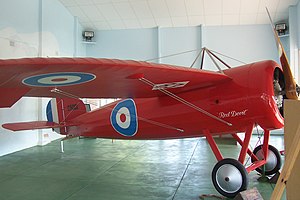| Bristol M.1 | |
|---|---|
 The only surviving Bristol monoplane, on display at Minlaton, South Australia, 2005 | |
| General information | |
| Type | Fighter |
| Manufacturer | Bristol Aeroplane Company |
| Designer | |
| Status | Out of service |
| Primary users | Royal Flying Corps |
| Number built | 130 |
| History | |
| Introduction date | 1917 |
| First flight | 14 July 1916 |
The Bristol M.1 Monoplane Scout was a British monoplane fighter of the First World War. It holds the distinction of being the only British monoplane fighter to reach production during the conflict.
During mid-1916, work commenced at Bristol on a new fighter aircraft as a private venture, headed by aeronautical engineer Frank Barnwell. The design was more radical than contemporary aircraft such as Airco's DH.5, which had a backward staggered biplane configuration. It featured a carefully streamlined circular cross-section fuselage built using conventional wood and fabric construction techniques to minimise manufacturing difficulty. On 14 July 1916, the first prototype, designated as the M.1A, conducted its maiden flight, flown by F.P. Raynham. During testing, the type quickly demonstrated its capabilities as a high speed aircraft for the era, possessing a maximum speed that was some 30–50 mph (48–80 km/h) higher than any of the contemporary German Fokker Eindecker and French Morane-Saulnier N monoplanes.
Despite its promise, only 130 aircraft were constructed. This was largely due to an institutional mistrust of the monoplane platform held by the British War Office and many pilots of the Royal Flying Corps (RFC) at that time, believing it to be accident-prone and inferior to the more common biplane configuration used by many of the M.1's contemporaries. As a consequence of the type being believed to possess too great a landing speed to be safely handled by the constrained French airfields on the Western Front, the M.1 was commonly deployed to the Middle East and the Balkans theatres instead. A single ace pilot, Captain Frederick Dudley Travers DFC of No. 150 Squadron RAF, flew the type, having successfully shot down several opponents. During December 1918, Lt. Dagoberto Godoy of the Servicio de Aviación Militar de Chile, flew from Santiago to Mendoza, Argentina, a feat which was recorded as being the first flight conducted across the Andes mountain chain.